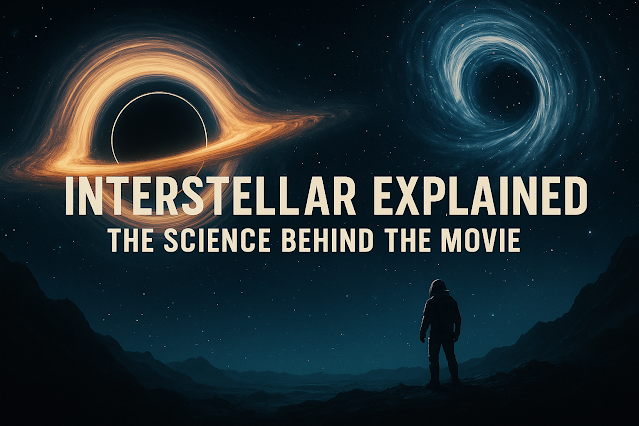Interstellar Explained: The Science Behind the Movie
Interstellar explained, Interstellar science, time dilation, black hole movie, Interstellar time travel, Kip Thorne, Gargantua, Interstellar ending
Introduction: A Sci-Fi Masterpiece Grounded in Reality
Christopher Nolan’s Interstellar (2014) is often praised as one of the most scientifically accurate science-fiction films ever made. Its gripping narrative, emotional depth, and stunning visuals are underpinned by real scientific theories — some of which were so groundbreaking that they led to published academic papers.
But what exactly is real and what’s fiction in Interstellar? Let's break down the movie's most fascinating scientific concepts in a way that's both accessible and awe-inspiring.
1. Gargantua: The Most Realistic Black Hole in Cinema
At the center of Interstellar is the black hole named Gargantua. This isn't your average movie black hole with a simple dark sphere. Instead, Gargantua is a spinning (or Kerr) black hole, rendered with guidance from Nobel Prize-winning physicist Kip Thorne.
✅ What’s Real?
- A black hole bends light due to its intense gravity — a phenomenon called gravitational lensing.
- The glowing disk (called an accretion disk) around Gargantua is made of matter spiraling into the black hole at near-light speeds, which is accurate.
- Gargantua’s spin is near the speed of light, which is why time slows so drastically near it (more on that soon).
❌ What’s Fictionalized?
- The brightness of the accretion disk was toned down for cinematic visibility. In reality, you'd be blinded.
2. Time Dilation: One Hour = Seven Years?
Perhaps the most mind-bending moment in Interstellar is when the team lands on Miller’s planet, which orbits close to Gargantua. Due to the black hole’s gravity, time moves slower on the planet — so much so that one hour there equals seven Earth years.
✅ Is This Possible?
Yes — this is an extreme but theoretically accurate effect of Einstein’s General Relativity. Gravity distorts spacetime, and near a massive object like Gargantua, time slows dramatically.
This phenomenon is called gravitational time dilation, and it’s not just science fiction — GPS satellites even have to account for time dilation due to Earth’s gravity!
❌ The Fictional Leap:
- Wormholes remain hypothetical. We’ve never observed one.
- Keeping a wormhole stable would require exotic matter with negative energy — something we’ve never created.
Still, Interstellar’s wormhole was modeled as accurately as possible within current theory.
4. The Fifth Dimension & The Tesseract
In the climax, Cooper falls into the black hole and ends up in a surreal, infinite library-like structure where he can interact with different points in time. This is the Tesseract, built by future humans (or “beings”) who exist in five dimensions.
✅ Theoretical Basis:
The concept comes from String Theory and brane cosmology, which propose that there could be more than four dimensions (three of space, one of time).
❌ Movie Liberty:
No current science allows us to access or perceive higher dimensions in the way the movie presents. But it serves as a poetic and symbolic visualization of quantum gravity and love transcending dimensions.
5. Planets Around a Black Hole?
Miller's, Mann's, and Edmunds’ planets all orbit Gargantua. Can planets even survive so close to a black hole?
✅ Possible But Unlikely:
A spinning black hole like Gargantua could theoretically have a habitable zone, as long as the radiation isn't deadly and the planet stays outside the event horizon.
However, radiation and tidal forces from the accretion disk would likely make life impossible without major shielding.
6. The Blight & Earth’s Collapse
In the movie, Earth is dying due to a crop-killing blight and dust storms. Humanity faces extinction, and space exploration becomes the only hope.
✅ Inspired by Real Threats:
- Climate change
- Soil degradation
- Fungal and bacterial plant diseases
- Overpopulation
While blight is fictional, the idea that Earth's environment could become uninhabitable isn’t far-fetched.
7. Cooper Station & The Ending Explained
Cooper ends up on Cooper Station, an orbiting space habitat near Saturn, named in honor of his daughter Murphy who saved humanity by solving gravity equations with the data Cooper sent from inside the black hole.
✅ Is Space Habitation Possible?
- Space habitats like O'Neill Cylinders are proposed for future colonization.
- Artificial gravity (by rotation), radiation shielding, and sustainable life support systems are key components.
❌ Mystery of the Black Hole Escape:
Surviving a trip into a black hole remains fiction. But in the film’s narrative, higher-dimensional beings help Cooper transcend time and space.
8. Kip Thorne: The Physicist Behind the Film
Kip Thorne, a theoretical physicist and 2017 Nobel Laureate, served as executive producer and scientific advisor. He ensured that:
- The depiction of black holes and wormholes was grounded in legitimate physics.
- The film didn’t violate known physical laws (though some speculations were dramatized).
He even co-wrote a book titled “The Science of Interstellar”, where he explains everything in detail.
A Work of Science, Fiction & Human Emotion
Interstellar is more than just a sci-fi movie; it’s a cinematic journey through the wonders of modern physics. While it takes creative liberties, its foundation in real science makes it a remarkable educational tool as well.
Through stunning visuals and emotional storytelling, it introduces mainstream audiences to black holes, time dilation, and the possibilities of space travel — all while exploring what it means to be human.
📚 Bonus: Learn More About Interstellar's Science
- 📖 The Science of Interstellar by Kip Thorne
- 🎥 The Universe - Episode on Black Holes (History Channel)
- 📘 A Brief History of Time by Stephen Hawking
🔍 FAQs
Q: Is Interstellar scientifically accurate?
A: Mostly. It was guided by real physics, especially General Relativity, with a few creative liberties.
Q: Can time actually move slower near a black hole?
A: Yes — it’s called gravitational time dilation.
Q: Are wormholes real?
A: Theoretically, yes. But none have been discovered yet.


